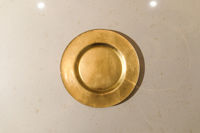Posted on February 15, 2021

Gold is one of the most sought-after precious metals; we use it in electronics, medicine and jewelry. While gold-plated products are ideal for electronic and medical applications, gold-plated jewelry isn't nearly as valuable as its solid-gold counterparts. Learning to tell the difference between a solid-gold and gold-plated piece can help you make wise investment decisions.
Gold plating is the process of applying a thin layer of gold to the surface of another metal or alloy. The Federal Trade Commission allows jewelers to stamp their gold-plated pieces as 'Gold Plate' if the plating is over 0.5 microns [1].
Gold plating techniques vary from jeweler to jeweler. You may find that some platings are thicker, sometimes 2.5 microns or more. The thicker the plating, the longer it will last and the more difficult it is to tell it apart from solid gold.
If you want to spot gold plating, you should learn about the plating process:
You also need to know the difference between gold plating and gold filling. To fill a piece, jewelers surround the core metal in a layer of gold, then apply pressure to bond the gold to the core, resulting in a thick, long-lasting outer layer. A thicker coating is better for longevity, but it will also make it more difficult for you to tell if the piece is solid gold.
The properties of gold make it the perfect metal to protect more reactive materials. Similar coating methods, once exclusive to jewelry, also work well in electronics and medicine.
Despite the cost of gold, it remains one of the best metals for improving efficiencies in circuit boards. Gold allows a circuit to run at a lower voltage, and a thin coating on an electronic component helps it to release heat.
Some common electronics with gold plating are:
Since gold is hypoallergenic and inert, it is an ideal metal for use on humans [3]. It is also common to see gold coatings on tungsten carbide surgeons' tools because it helps prevent corrosion. It can also be used on the nanoparticle level for therapeutic treatments.
Other uses include:
Gold plating is incredibly common in jewelry. Pure 24-karat gold is too expensive for many, and it's too soft and malleable to stand up to everyday wear and tear.
Jewelry that may have gold coatings include:
If you are ready to invest in a gold piece, you need to make sure the product is solid gold and not plated.
Gold isn't magnetic, but many of the base metals used in gold plating are. Pass a strong magnet over your piece. If it sticks or moves toward the magnet, then your piece isn't 100% gold. However, some base metals, like stainless steel, are also non-magnetic. Some pure gold can also be mixed with iron to improve its durability, so it's possible for anything less than a 24-karat gold piece to be slightly magnetic.
Since this test doesn't necessarily give you absolute results, you should use it in conjunction with other evaluations.
With this test, you make a scratch in the piece to reveal the base metal. Since gold plating is relatively thin, you don't need to make a deep scratch to see if your piece is plated. Since this test can affect the aesthetic quality of your piece, you should make the scratch in an inconspicuous area.
All gold jewelry and collectibles should have markings that denote the quality of the gold. Solid gold jewelry will have a simple karat number, such as 18K, and a jeweler's mark.
Gold-filled jewelry will have a GF and a number showing the gold density used. GP (gold plated), RGP (rolled gold plated) and HGE (heavy gold electroplating) are marks that will show the method of the plating.
A lack of markings usually means the piece does not contain gold. Modern hallmarking has been in place since 1905, though earlier pieces may still have other stamps to show the quality [4]. Regardless, you should always look for some sort of marking on your piece.
Gold plating wears off over time, so you can check for discolorations in your piece if it's older. Base metals, like iron, copper and nickel will look darker compared to the bright gold. The inside of an old ring will wear away the gold plating over time, revealing the base material. Between the links of a chain is another place where the plating will wear.
Knowing how to tell gold-plated jewelry from solid gold pieces takes some basic knowledge and a keen eye. If you're unsure of whether your piece is gold plated or solid gold, take it to a jeweler, where they will use advanced tests to determine the piece's authenticity and quality.
Article Sources:
[1] Federal Trade Commission. STATEMENT OF BASIS AND PURPOSE: FINAL REVISIONS TO THE JEWELRY GUIDES, https://www.ftc.gov/system/files/documents/public_statements/1393857/g71001_jewelry_guides_statement_of_basis_and_purpose_final_8-8-18.pdf. Accessed September 19, 2020.
[2] Thermo Fisher. How Gold Plating is Done, Step by Step, https://www.thermofisher.com/blog/metals/how-gold-plating-is-done-step-by-step/. Accessed September 19, 2020.
[3] MIMS. 4 medical uses of gold, https://today.mims.com/4-medical-uses-of-gold. Accessed 19 September 2020.
[4] Manufacturing Jewelers & Suppliers of America. Stamping and Marking, https://mjsa.org/publicationsmedia/compliance_guides/stamping_and_marking. Accessed 19 September 2020.